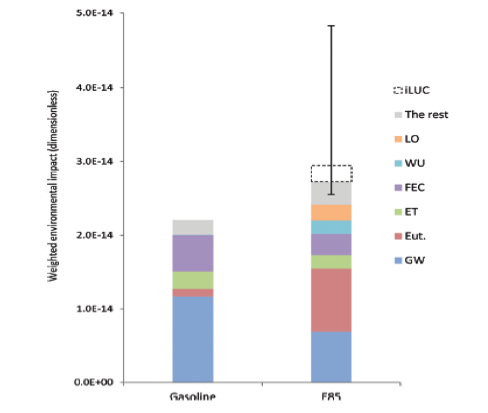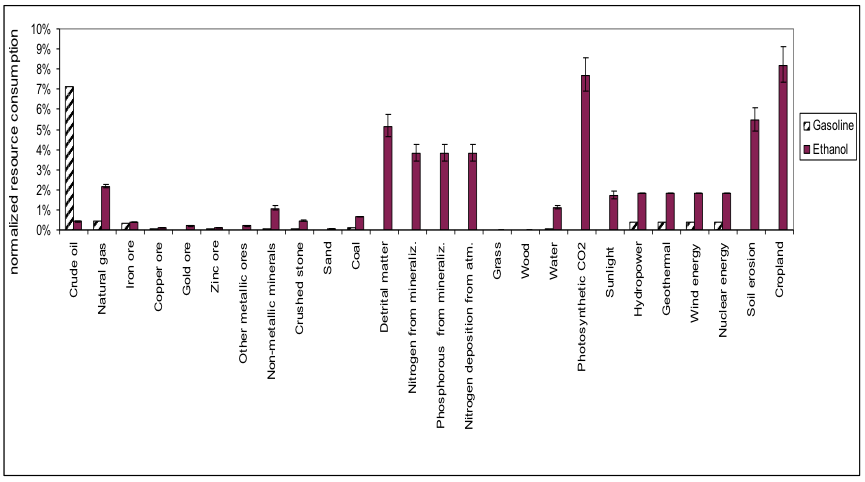Blog
Environmental burden shifting and sustainability criteria for biofuels
Biofuels are here for three reasons – climate change mitigation, energy security and to increase rural incomes. The supposed climate change mitigation potential of biofuels comes with the idea that renewability implies carbon neutrality. However, with the introduction of the systems approach of analyzing environmental costs and benefits, it has emerged that biofuels, especially first generation biofuels, do not offer environmental and human health benefits on all fronts. The systems approach, such as life cycle analysis (LCA), looks into far ranging impacts including GHG emissions from indirect land use change (ILUC). We find that in many cases we may not expect to achieve net greenhouse gas reductions from biofuel policies – but also that even where climate change mitigation might be effective, there can be other tradeoffs in choosing biofuels, indicating a potential risk of environmental burden shifting for policies that solely focus on GHG mitigation.
For example, one primary concern for bioethanol has been NOx emissions. Besides directly impacting human health and ecosystems, NOx emissions increase the concentrations of secondary air pollutants- ozone and peroxyacetyl nitrate (PAN). PAN is known to cause damage to crops. Increases in ozone concentrations pose human health hazards. A study by Mark Jacobson indicated that the use of E85 may increase mortality, hospitalization and asthma related to ozone by 9% in Los Angeles and 4% in the U.S. compared to gasoline. In addition, the use of ethanol increases emissions of acetaldehyde and VOCs.
An environmental impact study conducted for the Renewable Fuel Standards (RFS2) shows that meeting the target of 36 billion gallons of biofuels by 2022 would increase the loadings of nitrogen, phosphorous, and sediment into rivers relative to the AEO 2007 reference case. According to the assessment, the Upper Mississippi River basin may likely receive additional annual loadings of 9 million kg, 0.5 million kg, and 10 million kg for nitrogen, phosphorous, and sediment, respectively.
Increased nitrogen and phosphorous loadings into the Mississippi River contribute to eutrophication and the “dead zone” in the Gulf of Mexico—an area of the Gulf spreading outward from the Mississippi Delta that is starved of oxygen because of the excessive amounts of these plant nutrients dumped into it by the river, and therefore inhabitable by aquatic species. It has severely harmed the fishing industry in the Gulf. The size of the dead zone has increased in recent years, and according to Texas A&M researchers the size last year may have been the largest ever, measuring about 9,400 square miles in 2011.
Biofuels from managed agriculture tend to be resource intensive by consuming ecological goods and services; some of which are not renewable. As the chart below shows, corn ethanol consumes less crude oil but consumes more of other fossil fuels, minerals, water, land, and other renewable sources as compared to gasoline.
In addition, the existing literature on ethanol from food crops suggests that it has higher acidification and eutrophication potential compared to gasoline, leading to undesirable impacts on the environment.
Until recently, LCA studies tended to show that biofuels have a lower global warming potential. However, even this has changed since the quantification of indirect land use change (ILUC) was introduced. ILUC occurs when biofuels create new demand for cropland due to crop displacement and change in crop trade. For corn ethanol, ILUC GHG emissions may range from 10 to 340 gCO2e /MJ. A recent IFPRI study suggested that biodiesel from palm oil, soybean biodiesel, and rapeseed would have negative GHG savings when ILUC is included.
Impacts from global warming are different from acidification potential or human toxicity. The question then becomes, when biofuels perform well in one category but badly in others, how do we evaluate various biofuel options and how do we discourage a policy that solves one problem but creates another by problem shifting?
Generally speaking, we use mid-point or end-point impact assessment in LCA to measure aggregate environmental impacts of a given process. ‘Mid-point’ impact assessment quantifies the potential for causing a negative impact in a specific environmental or human health category, such as eutrophication, ozone depletion and human toxicity. ‘End-point’ assessment quantifies the aggregate damage to human health and the environment by, for instance, estimating disability adjusted life years (DALY) or loss of species. In the case of biofuels, most LCA studies have focused mainly on GHG emissions, less on questions such as eutrophication, acidification, ozone depletion, and ecotoxicity.
One way of evaluating fuels is to combine many types of environmental impact into a single weighted environmental impact metric using characterization factors, weighting factors and normalization. Characterization factors enable us to convert emissions and resource consumption into environmental impacts such as ozone depletion and resource depletion. The commonly used characterization factors come from TRACI (developed by the USEPA) and Eco-indicator 99. Weighting factors give us an idea about the relative importance of one impact vs. another, while normalization gives us an idea about the relative magnitude of a given impact. According to the National Institute of Standards and Technology (NIST) study, global warming has an environmental impact importance (weight) of 29%, whereas eutrophication and acidification have an environmental impact importance of 6% and 3%, respectively. The weighting factors developed by the NIST use a decision criteria analysis and inputs from LCA stakeholders on the importance of environmental impact categories.
A recently published study by Yang et al. (2012) aggregates various types of environmental impact into single scores using the weighting factors derived from the NIST approach for the purpose of comparing environmental impact of corn ethanol and gasoline. The chart below, which comes from this new study, succinctly displays the tradeoff in choosing corn ethanol over gasoline and its overall weighted impact. In this analysis, when we look at it from a climate change mitigation perspective, ethanol is expected to induce less climate change impact than gasoline even when ILUC is considered. However, E85 performs worse environmentally than gasoline on most other criteria considered and has a higher overall negative environmental impact based on this metric. Yang et al. call this ‘environmental burden shifting’, because in an attempt to reduce climate impacts we are increasing other environmental impacts.

Note that this particular example uses an ILUC factor of 15 g CO2e/MJ based on the recent study by Tyner et al. (2011). Using ILUC factors from other studies would alter the outcome. Nevertheless, even assuming a GHG benefit, corn ethanol has larger weighted impacts than petroleum on land and water use and eutrophication. While there are subjectivity and other limitations associated with the use of an aggregate score, the weighted impact approach may be appealing for decision makers in designing the right policies to provide a market signal for the development of sustainable biofuels by minimizing the impact on all fronts.
Sustainability criteria developed by various organizations such as the Roundtable on Sustainable Biofuels (RSB), Global Bioenergy Partnership (GBEP), and Better Sugarcane Initiative (BSI) aim to reduce the risk of environmental burden shifting of biofuels by promoting practices that improve the overall aspects of biofuel production. They include environmental criteria such as GHG emissions, water consumption, fertilizer and pesticide applications, biodiversity and social criteria such as labor rights and minimum wages.
With respect to environmental burden shifting of biofuels, the importance of sustainability criteria in low carbon fuel policies has become glaringly apparent. In response, some low carbon fuel policies such as the Renewable Energy Directive (RED) and the UK Renewable Transport Fuel Obligation (RTFO) have included minimal sustainable criteria to govern the production of biofuels. In the U.S., the California Air Resources Board (CARB) has taken an initiative to establish sustainability indicators for its Low Carbon Fuel Standard by setting up a working group on sustainability.
A holistic approach to problem solving has the potential to drive biofuels on a more sustainable path, as regards the non-climate change related environmental impacts. Therefore, governments should strive towards the adequate integration of robust sustainability principles in their low carbon fuel policies.

